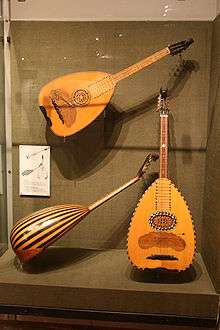Laouto

The laouto (Greek: λαούτο) is a long-neck fretted instrument of the lute family, found in Greece and Cyprus, and similar in appearance to the oud. The name comes from the lute. It is played in most respects like the oud (plucked with a long plectrum).
Construction
Unlike the oud and other short-necked lutes, the laouto has a higher string tension due to its longer neck and hence brighter in tone than the oud. The laouto also tends to have only one sound hole (sometimes two) whereas the oud family tend to have three. In this respect and because the use of movable frets, the laouto more closely resembles the lute, while sounding more like the oud.
The soundboard is often made of spruce or cedar wood, while the body is usually made of a harder wood such as maple or walnut. This is a practice consonant with the construction of other (round-backed) lutes.
The 11 frets of the neck are removable (and can be re-positioned for differing intervals) and made of nylon (resembling the gut/nylon frets of the lute). Up to 9 wooden frets, mounted on the soundboard, are fixed. The intervals of the frets may be more frequent than that of a guitar to permit the playing of maqams as found in the music of Byzantium.
The strings of the laouto were traditionally of gut, although the modern laouto has steel (or steel wound nylon) strings similar to those of the bouzouki.
Tuning
The laouto's eight strings are paired, tuned an octave apart. The interval from one pair to the next is tuned in fifths (Cc-Gg-Dd-aa). The Laouto has a re-entrant tuning, Gg tuned a fourth lower than Cc.
The two primary contemporary variants of the laouto, one somewhat smaller than the other, are to be found on mainland Greece and on the island of Crete. The larger sized instrument (wider body) is played mainly on the island of Crete and tends to be tuned differently ( Gg - Dd - Aa - ee ), the re-entrant tuning is still a characteristic of the Cretan laouto (or lagouto (Greek: λαγούτο)), because Dd is a fourth lower than Gg. In Cyprus, Cypriot laouto is tuned C - G - D - A (https://www.youtube.com/watch?v=5bkV5V_eye4).
The role of the laouto in Greek traditional music is primarily that of accompaniment. The laouto is often played in a duo (the one laouto tuned more bass than the other) with the Cretan lyra or with the violin (in Cyprus).
See also
External links
- http://www.we-love-crete.com/cretan-music.html
- Atlas of plucked musical instruments
- Solo Cretan laouto video